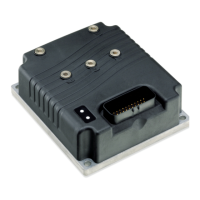94
Curtis 1222 Manual, os 15
2 9 J A N U A R Y 2 0 1 3 D R A F T
6 — INTERFACE WITH MASTER
TractionMotorRPMCAN is the rpm of the traction motor and can be used to
determine when to steer (see
Interlock Enabled Speed, page 45).
TractionIsReady is used if programmed Contactor Type = 2; it has bit 0 = contactor
is open, and bit 1 = contactor is closed.
CANInterlock is the interlock from the traction system that is used if programmed
Interlock Type = 3; it has bit 0 = interlock is open, and bit 1 = interlock is
closed.
WheelPosition is the position of the steered wheel, in degrees. This is used by
the traction system to determine the maximum allowed speed.
TractionCutback is the percentage of its MaxSpeed that the traction controller
is allowed to run.
TractionFaultAction has bit 0 = no fault, bit 1 = stop traction, bit 2 = reduce
traction speed, and bit 3 = no action. See right-hand column in the
troubleshooting chart (Table 6).
EnableTraction has bit 0 = stop and bit 1 = traction enabled.
EnableTractionInverted is the inverse of EnableTraction.
TractionCutbackInverted is the inverse of TractionCutback.
Switches has bit 0 = Interlock Input 1, bit 1 = Home Input 2, bit 2 = Interlock
Input 3, and bit 3 = Home Input 4.
Emergency Message Configuration
The 1222 sends an emergency message any time a fault is set or cleared. For a descrip
-
tion of the variables see the troubleshooting chart (Table 6) and the generic Curtis
CANopen specification.
Byte 1 — ErrorCode (Low Byte)
Byte 2 — ErrorCode (High Byte)
Byte 3 — ErrorRegister (CAN Object 0x1001)
0x01 if any fault is present or 0x00 is no faults
Byte 4 — SubCode See the troubleshooting chart
Byte 5 — FlashCode See the troubleshooting chart
Byte 6 — TractionFaultAction See the troubleshooting chart
Byte 7 — Reserved
Byte 8 — Reserved

